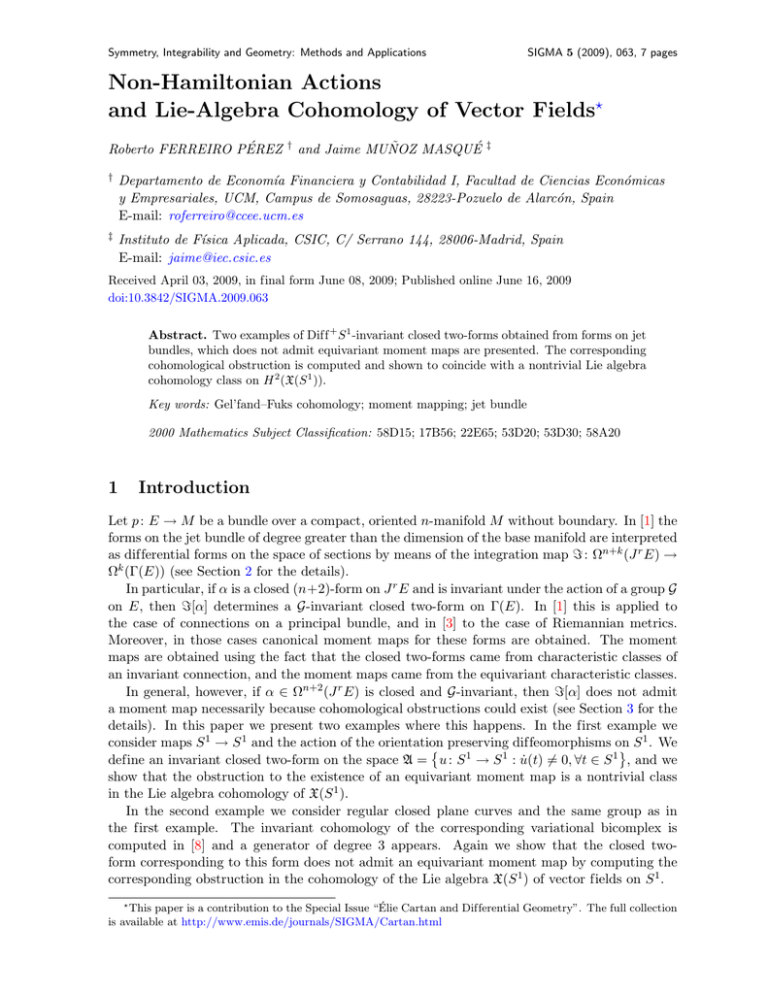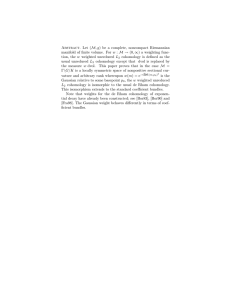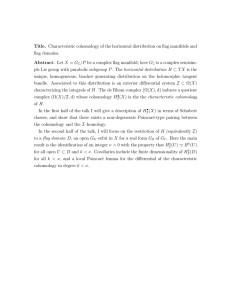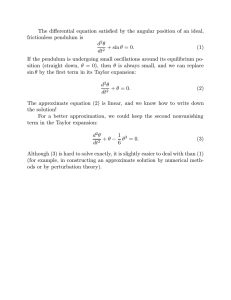Non-Hamiltonian Actions ds ?
advertisement

Symmetry, Integrability and Geometry: Methods and Applications
SIGMA 5 (2009), 063, 7 pages
Non-Hamiltonian Actions
and Lie-Algebra Cohomology of Vector Fields?
Roberto FERREIRO PÉREZ
†
and Jaime MUÑOZ MASQUÉ
‡
†
Departamento de Economı́a Financiera y Contabilidad I, Facultad de Ciencias Económicas
y Empresariales, UCM, Campus de Somosaguas, 28223-Pozuelo de Alarcón, Spain
E-mail: roferreiro@ccee.ucm.es
‡
Instituto de Fı́sica Aplicada, CSIC, C/ Serrano 144, 28006-Madrid, Spain
E-mail: jaime@iec.csic.es
Received April 03, 2009, in final form June 08, 2009; Published online June 16, 2009
doi:10.3842/SIGMA.2009.063
Abstract. Two examples of Diff + S 1 -invariant closed two-forms obtained from forms on jet
bundles, which does not admit equivariant moment maps are presented. The corresponding
cohomological obstruction is computed and shown to coincide with a nontrivial Lie algebra
cohomology class on H 2 (X(S 1 )).
Key words: Gel’fand–Fuks cohomology; moment mapping; jet bundle
2000 Mathematics Subject Classification: 58D15; 17B56; 22E65; 53D20; 53D30; 58A20
1
Introduction
Let p : E → M be a bundle over a compact, oriented n-manifold M without boundary. In [1] the
forms on the jet bundle of degree greater than the dimension of the base manifold are interpreted
as differential forms on the space of sections by means of the integration map = : Ωn+k (J r E) →
Ωk (Γ(E)) (see Section 2 for the details).
In particular, if α is a closed (n+2)-form on J r E and is invariant under the action of a group G
on E, then =[α] determines a G-invariant closed two-form on Γ(E). In [1] this is applied to
the case of connections on a principal bundle, and in [3] to the case of Riemannian metrics.
Moreover, in those cases canonical moment maps for these forms are obtained. The moment
maps are obtained using the fact that the closed two-forms came from characteristic classes of
an invariant connection, and the moment maps came from the equivariant characteristic classes.
In general, however, if α ∈ Ωn+2 (J r E) is closed and G-invariant, then =[α] does not admit
a moment map necessarily because cohomological obstructions could exist (see Section 3 for the
details). In this paper we present two examples where this happens. In the first example we
consider maps S 1 → S 1 and the action of the orientation
diffeomorphisms on
S 1 . We
preserving
define an invariant closed two-form on the space A = u : S 1 → S 1 : u̇(t) 6= 0, ∀t ∈ S 1 , and we
show that the obstruction to the existence of an equivariant moment map is a nontrivial class
in the Lie algebra cohomology of X(S 1 ).
In the second example we consider regular closed plane curves and the same group as in
the first example. The invariant cohomology of the corresponding variational bicomplex is
computed in [8] and a generator of degree 3 appears. Again we show that the closed twoform corresponding to this form does not admit an equivariant moment map by computing the
corresponding obstruction in the cohomology of the Lie algebra X(S 1 ) of vector fields on S 1 .
?
This paper is a contribution to the Special Issue “Élie Cartan and Differential Geometry”. The full collection
is available at http://www.emis.de/journals/SIGMA/Cartan.html
2
2
R. Ferreiro Pérez and J. Muñoz Masqué
The integration map
Let p : E → M be a bundle over a compact, oriented n-manifold M without boundary, and
let J r E be its r-jet bundle with projections pr : J r E → M , pr,s : J r E → J s E for s < r.
A diffeomorphism φ ∈ DiffE is said to be projectable if there exists φ ∈ DiffM satisfying
φ ◦ p = p ◦ φ. We denote by ProjE the space of projectable diffeomorphism of E, and we denote
by Proj+ E the subgroup of elements such that φ ∈ Diff + M , i.e., φ is orientation preserving.
The space of projectable vector fields on E is denoted by projE, and can be considered as the
Lie algebra of ProjE. We denote by φ(r) (resp. X (r) ) the prolongation of φ ∈ ProjE (resp.
X ∈ projE) to J r E.
Let Γ(E) be the space of global sections of E considered as an infinite dimensional Frechet
manifold (e.g. see [6, Section I.4]). For every s ∈ Γ(E) we have Ts Γ(E) ∼
= Γ(M, s∗ V (E)), where
V (E) denotes the vertical bundle of E. The group ProjE acts naturally on Γ(E) in the following
way. If φ ∈ ProjE, we define φΓ(E) ∈ DiffΓ(E) by φΓ(E) (s) = φ ◦ s ◦ φ−1 , for all s ∈ Γ(E). In
a similar way, a projectable vector field X ∈ projE induces a vector field XΓ(E) ∈ X(Γ(E)).
Let jr : M × Γ(E) → J r E, jr (x, s) = jxr s be the evaluation map. We define a map
= : Ωn+k (J r E) → Ωk (Γ(E)),
by setting
Z
=[α] =
(jr )∗ α,
M
for α ∈ Ωn+k (J r E). If α ∈ Ωk (J r E) with k < n, we set =[α] = 0. The operator = satisfies the
following properties:
Proposition 1 (cf. [1]). For all α ∈ Ωn+k (J r E) the following formulas hold:
1. =[dα] = d=[α].
2. =[(φ(r) )∗ α] = φ∗Γ(E) =[α], for every φ ∈ Proj+ E.
3. =[LX (r) α] = LXΓ(E) =[α] for every X ∈ proj E.
4. =[ιX (r) α] = ιXΓ(E) =[α] for every X ∈ proj E.
If α ∈ Ωn+k (J r E), s ∈ Γ(E), X1 , . . . , Xk ∈ Ts Γ(E) ∼
= Γ(M, s∗ V (E)), then
Z
=[α]s (X1 , . . . , Xk ) =
(j r s)∗ (ιX (r) · · · ιX (r) α).
M
k
(1)
1
There exists a close relationship between the integration map = and the variational bicomplex,
see [2] for the details.
More generally, if R ⊂ J r E is an open subset and R = {s ∈ Γ(E) : jxr s ∈ R, ∀ x ∈ M } is the
space of holomonomic sections of R, then the integration map defines a map = : Ωn+k (R) →
Ωk (R).
3
Cohomological obstructions to the existence of moment maps
Recall the obstructions for the existence of a moment map for an invariant closed two-form, e.g.,
see [7].
Let ω be a closed two-form on M and G a group acting on M and preserving ω. We have an
infinitesimal action g → X(M ), X 7→ XM .
Non-Hamiltonian Actions and Lie-Algebra Cohomology of Vector Fields
3
The action is said to be weakly Hamiltonian if for every X ∈ g the form ιXM ω is exact, i.e.,
if there exists a map µ : g → C ∞ (M ) such that for every X ∈ g we have ιXM ω = d(µ(X)).
The action is said to be Hamiltonian if there exists a G-equivariant moment map. At the
infinitesimal level, if µ : g → C ∞ (M ) is G-equivariant then we have LX µ = 0 for every X ∈ g
and the converse is true for connected groups.
If the action is weakly Hamiltonian, the obstructions for the action to be Hamiltonian lie in
H 2 (g): If µ : g → C ∞ (M ) satisfies ιXM ω = d(µ(X)), we define τ : g × g → R by,
τ (X, Y ) = (LY µ)(X) = µ([X, Y ]) + LYM (µ(X)).
It can be seen that τ is closed, that the cohomology class on H 2 (g) is independent of the µ chosen,
and that the cohomology class of τ on H 2 (g) vanishes if and only if there exists a moment map
µ0 : g → C ∞ (M ) such that ιXM ω = d(µ0 (X)) and LX µ0 = 0 for every X ∈ g. In particular, if
the cohomology class of τ is not zero, then the action is not hamiltonian.
4
Cohomology of smooth vector f ields on S 1
In our examples we apply the preceding results to the action of the diffeomorphism group of S 1 .
Hence the Lie algebra cohomology of X(S 1 ) appears. This cohomology was first computed by
Gel’fand and Fuks in [5] and is well known (e.g. see [4]). The continuous cohomology H(X(S 1 )) is
isomorphic to the tensor product of a polynomial ring with one two-dimensional generator a and
the exterior algebra with one three-dimensional generator b. The two-dimensional generator a
is given by,
Z df d2 g dg d2 f
a(X, Y ) =
−
dt,
dt dt2
dt dt2
S1
d
d
where X = f (t) dt
, Y = g(t) dt
.
5
Mappings S 1 → S 1
In this first example we consider the trivial bundle E = S 1 × S 1 → S 1 , whose sections are
mappings u : S 1 → S 1 , and the action of Diff + S 1 on E by (φ, (t, u)) 7→ (φ(t), u) for φ ∈ Diff + S 1
and (t, u) ∈ S 1 × S 1 .
The coordinates on S 1 × S 1 are denoted by (t, u) and those on J 2 E by (t, u, u̇, ü).
d
If X = f (t) dt
∈ X(S 1 ), then its prolongation to J 2 E is given by,
X
(2)
∂
df ∂
= f − u̇
−
∂t dt ∂ u̇
d2 f
df
u̇ + 2 ü
2
dt
dt
∂
.
∂ ü
(2)
We consider the open subset A ⊂ J 2 E defined by the condition u̇ 6= 0, which is Diff + S 1 invariant, and the form
σ=
1
dt ∧ du̇ ∧ dü ∈ Ω3 (A).
u̇2
It is readily seen that σ is closed and that LX (2) σ = 0 for every X ∈ X(S 1 ). By applying the
integration operator = we obtain a Diff + S 1 -invariant closed two-form ω = =[σ] ∈ Ω2 (A) on the
space A of holonomic sections of A
A = u : S 1 → S 1 : u̇(t) 6= 0, ∀ t ∈ S 1 .
4
R. Ferreiro Pérez and J. Muñoz Masqué
In our case, if s : S 1 → S 1 × S 1 is the section corresponding to u : S 1 → S 1 , then Ts Γ(A) ∼
=
Γ(S 1 , s∗ V (E)) ∼
= Γ(S 1 , T S 1 ).
∂
In local coordinates, if H = h(t) ∂u
, then its prolongation to J 2 E is given by,
H (2) = h
∂
dh ∂
d2 h ∂
+
+ 2
.
∂u
dt ∂ u̇
dt ∂ ü
Using this expression and formula (2) we obtain the explicit expression of ω:
∂
∂
Proposition 2. If H, K ∈ Ts Γ(A) are given by H = h(t) ∂u
, K = k(t) ∂u
, and u : S 1 → S 1 then
Z
ωu (H, K) =
S1
du
dt
−2 d2 h dk dh d2 k
−
dt2 dt
dt dt2
dt.
Moreover, we have σ = dα, where α = u̇−1 dt ∧ dü, and then,
ιX (2) σ = ιX (2) dα = LX (2) α − d(ιX (2) α),
for all X ∈ X(S 1 ). By using (2) we also obtain,
d2 f 1
df du̇
LX (2) α = − 2 dt ∧ du̇ = d −
,
dt u̇
dt u̇
and hence,
df du̇
ιX (2) σ = d −
− ιX (2) α
dt u̇
= d(ρ(X)),
where
ρ(X) = −
df du̇
− ιX (2) α.
dt u̇
Accordingly, the action of Diff + S 1 on (A, ω) is weakly Hamiltonian with moment map µ(X) =
=[ρ(X)], ∀ X ∈ X(S 1 ), as we have
ιXA ω = ιXA =[σ] = =[ιX (2) σ] = =[d(ρ(X))] = d (=[ρ(X)]) = d(µ(X)).
The explicit expression of µ is the following:
d
Proposition 3. If X = f (t) dt
and u : S 1 → S 1 , then
Z
µ(X)u = −
S1
du
dt
−1 d3 u
df d2 u d2 f du
f 3 +3
+ 2
dt
dt dt2
dt dt
dt.
However, the action is not Hamiltonian.
d
d
Proposition 4. If X = f (t) dt
, Y = g(t) dt
, then
Z
τ (X, Y ) = −
S1
d2 f dg df d2 g
−
dt2 dt
dt dt2
dt.
Proof . From the definition of τ we have
τ (X, Y ) = LYA µ(X) + µ([X, Y ]) = =[LY (2) ρ(X)] + =[ρ([X, Y ])]
= =[LY (2) ρX) + ρ([X, Y ])].
Non-Hamiltonian Actions and Lie-Algebra Cohomology of Vector Fields
5
From the definition of ρ we have
dx du̇
LY (2) ρ(X) + ρ([X, Y ]) = LY (2) −
− LY (2) (ιX (2) α)
dt u̇
d
dg
dg du̇
−
f
−f
− ι[X (2) ,Y (2) ] α.
dt
dt
dt u̇
By using (2) we obtain
d2 g du̇ df d2 g
dt,
LY (2) (ιX (2) α) + ι[X (2) ,Y (2) ] α = ιX (2) (LY (2) α) = −f 2
−
dt u̇
dt dt2
df du̇
d2 f du̇ df d2 g
LY (2) −
= −g 2
+
dt,
dt u̇
dt u̇
dt dt2
2
d
dg
df du̇
d g
d2 f du̇
f
−g
= f 2 −g 2
,
dt
dt
dt u̇
dt
dt
u̇
and hence,
LY (2) ρ(X) + ρ([X, Y ]) = 2
df d2 g
dt.
dt dt2
As
df d2 g
dt = −
2
dt dt2
we finally obtain,
Z
τ (X, Y ) =
d2 f dg df d2 g
−
dt2 dt
dt dt2
df d2 g
2
dt = −
2
S 1 dt dt
Z
S1
dt + d
df dg
dt dt
,
d2 f dg df d2 g
−
dt2 dt
dt dt2
dt.
Accordingly to Section 4 the expression obtained in Proposition 5 determines a non-trivial
class on the Lie algebra cohomology of X(S 1 ), and hence hτ i =
6 0 in H 2 (X(S 1 )). Hence we obtain
the following
Corollary 1. The action of Diff + S 1 on (A, ω) is not Hamitonian, i.e., ω does not admit
a Diff + S 1 -equivariant moment map.
6
Regular plane curves
Let E = S 1 × R2 → S 1 be the trivial bundle. Global sections of E are none other than
mappings u : S 1 → R2 , u(t) = (x(t), y(t)). Coordinates on E are denoted by (t, x, y) and by
(t, x, y, ẋ, ẏ, ẍ, ÿ) the coordinates on J 2 E.
We consider the open set R ⊂ J 2 E defined by the condition ẋ2 + ẏ 2 6= 0, and corresponding
to the 2-jets of regular curves. The holonomic sections of R constitute the space Reg ⊂ Γ(E)
of closed regular plane curves,
n
o
Reg = u : S 1 → R2 : |u̇(t)|2 6= 0, ∀ t ∈ S 1 .
The group DiffS 1 acts on E by (t, u) 7→ (φ(t), u), for every φ ∈ DiffS 1 . This action induces
d
∈ X(S 1 ), then its
an action on J 2 E and clearly R is invariant under this action. If X = f dt
prolongation to J 2 E is given by
2
2
∂
df ∂
df ∂
d f
df
∂
d f
df
∂
(2)
X = f − ẋ
− ẏ
−
ẋ + 2 ẍ
−
ẏ + 2 ÿ
.
2
2
∂t dt ∂ ẋ dt ∂ ẏ
dt
dt
∂ ẍ
dt
dt
∂ ÿ
6
R. Ferreiro Pérez and J. Muñoz Masqué
Let us consider the 3-form on R given by
σ = v −2 dt ∧ dv ∧ dv̇,
p
where v = ẋ2 + ẏ 2 , v̇ = v −1 (ẋẍ+ẏ ÿ). This form appears in [8] as a generator of the cohomology
for the invariant cohomology of the variational bicomplex for regular plane curves. It is easily
checked directly that LX (2) σ = 0 for every X ∈ X(S 1 ) and that dσ = 0.
Let ω = =[σ] ∈ Ω2 (R), where = : Ω3 (R) → Ω2 (Reg) is the integration map. By the properties
of =, we know that ω is a closed and Diff + S 1 -invariant two-form on Reg.
We apply the results of Section 3 to the – infinite-dimensional – case of the Diff + S 1 -action
on (Reg, ω).
Let α ∈ Ω2 (R) be the form given by, α = v −1 dt ∧ dv̇. Clearly, we have dα = σ, and hence
ιX (2) σ = ιX (2) dα = LX (2) α − d(ιX (2) α), for every X ∈ X(S 1 ).
As a direct computation shows, we have
df
v,
dt
d2 f
df
LX (2) v̇ = − 2 v − 2 v̇,
dt
dt
LX (2) v = −
(3)
(4)
and hence
d2 f
dv
LX (2) α = − 2 dt ∧
= −d
dt
v
df
dt
dv
df dv
∧
=d −
.
v
dt v
Hence we obtain
df dv
df dv
ιX (2) σ = d −
− d(ιX (2) α) = d −
− ιX (2) α .
dt v
dt v
If we set
ρ(X) = −
df dv
− ιX (2) α,
dt v
then the action is weakly Hamiltonian, with moment map
µ(X) = =[ρ(X)],
∀ X ∈ X(S 1 ).
However, the action is not Hamiltonian.
d
d
Proposition 5. If X = f (t) dt
, Y = g(t) dt
, then
Z 2
d f dg df d2 g
τ (X, Y ) = −
−
dt.
dt2 dt
dt dt2
S1
Proof . We have
τ (X, Y ) = LYReg µ(X) + µ([X, Y ]) = =[LY (2) ρ(X)] + =[ρ([X, Y ])]
= =[LY (2) ρ(X) + ρ([X, Y ])],
and
df dv
LY (2) ρ(X) + ρ([X, Y ]) = LY (2) −
− LY (2) (ιX (2) α)
dt v
d
dg
df dv
−
f
−g
− ι[X (2) ,Y (2) ] α.
dt
dt
dt v
(5)
Non-Hamiltonian Actions and Lie-Algebra Cohomology of Vector Fields
7
By using (3), (4), and (5) we obtain
d2 g
LY (2) (ιX (2) α) + ι[X (2) ,Y (2) ] α = ιX (2) (LY (2) α) = 2
dt
2
2
d f dv df d g
df dv
=− 2g
+
dt,
LY (2) −
dt v
dt
v
dt dt2
2
dg
d
df dv
d g
d2 f dv
f
−g
= f 2 −g 2
,
dt
dt
dt v
dt
dt
v
dv df
−f
− dt ,
v
dt
and hence,
LY (2) ρ(X) + ρ([X, Y ]) = 2
df d2 g
dt.
dt dt2
As
df d2 g
dt = −
2
dt dt2
d2 f dg df d2 g
−
dt2 dt
dt dt2
we finally obtain
Z
τ (X, Y ) =
df d2 g
2
dt = −
2
S 1 dt dt
Z
S1
dt + d
df dg
dt dt
,
d2 f dg df d2 g
−
dt2 dt
dt dt2
dt.
As we obtain the same result as that in the preceding example, we also obtain the following
Corollary 2. The action of Diff + S 1 on (Reg, ω) is not Hamitonian, i.e., ω does not admit
a Diff + S 1 -equivariant moment map.
Acknowledgements
Part of this work started during the stay of the first author at Utah State University under
the advice of Professor Ian Anderson. The computations were first obtained by using MAPLE
package “Vessiot”. Supported by Ministerio de Ciencia e Innovación of Spain under grant #
MTM2008–01386.
References
[1] Ferreiro Pérez R., Equivariant characteristic forms in the bundle of connections, J. Geom. Phys. 54 (2005),
197–212, math-ph/0307022.
[2] Ferreiro Pérez R., Local cohomology and the variational bicomplex, Int. J. Geom. Methods Mod. Phys. 5
(2008), 587–604.
[3] Ferreiro Pérez R., Muñoz Masqué J., Pontryagin forms on (4k − 2)-manifolds and symplectic structures on
the spaces of Riemannian metrics, math.DG/0507076.
[4] Fuks D.B., Cohomology of infinite-dimensional Lie algebras, Contemporary Soviet Mathematics, Consultants
Bureau, New York, 1986.
[5] Gel’fand I.M., Fuks D.B., Cohomologies of the Lie algebra of vector fields on the circle, Funkcional. Anal.
i Prilozen. 2 (1968), no. 4, 92–93.
[6] Hamilton R., The inverse function theorem of Nash and Moser, Bull. Amer. Math. Soc. (N.S.) 7 (1982),
65–222.
[7] McDuff D., Salamon D., Introduction to symplectic topology, Oxford Mathematical Monographs, Oxford
Science Publications, The Clarendon Press, Oxford University Press, New York, 1995, 1995.
[8] Pohjanpelto J., Anderson I.M., Infinite-dimensional Lie algebra cohomology and the cohomology of invariant
Euler–Lagrange complexes: a preliminary report, in Differential Geometry and Applications (Brno, 1995),
Masaryk Univ., Brno, 1996, 427–448.


